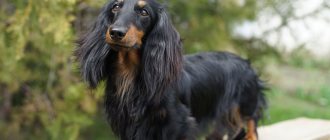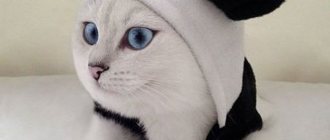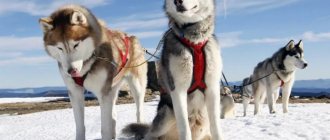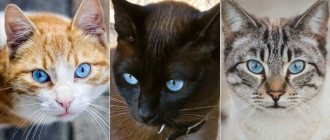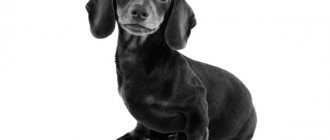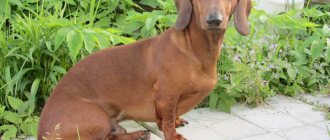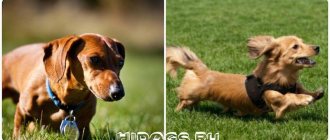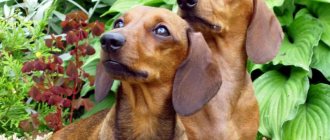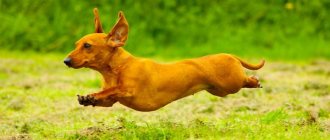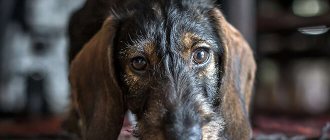Origin story: how do albinos appear?
Before the official recognition of the breed, breeders bred dogs of any color, as they were primarily interested in the working qualities of dachshunds.
White, dark-spotted dogs similar to dachshunds are depicted in ancient paintings and frescoes, indicating that these colors were quite popular in the past..
However, after the standard was approved, white dachshunds were excluded from breeding, but despite this, such puppies continue to appear from time to time.
What causes the appearance of white color in these dogs?
There may be several reasons for this:
- Lightened to white cream.
- Leucism, or, in other words, true white color.
- Extreme degree of spotting. These dogs have individual colored hairs or small pigment spots on the skin.
- Albinism. In this case, the dog completely lacks pigmentation due to the fact that a genetic failure prevents the synthesis of pigments.
The birth of albino puppies is often caused by the mating of two marble-colored dogs.
Training and education
Many people believe that small dogs only require grooming, while large breeds require training. Small dogs without proper human guidance become capricious. Few people will like this behavior. As soon as the rabbit dachshund puppy comes into your home, you can begin training. The primary task is to teach him to use a leash. This is a matter of animal safety. While out for a walk, a dachshund may chase a squirrel or encounter an aggressive cat. Until the baby has firmly grasped the commands, she will need control.
The dog masters the minimum set of commands from the age of 4 months. She has a lively mind and an excellent memory. Classes are conducted in the form of an entertaining game. A small obstacle on the path to success can be the stubbornness of a dachshund. But a loving and patient owner can easily cope with this. Rudeness and physical pressure are unacceptable! This behavior causes psychological trauma to the animal and remains in the memory for a long time. The dog's character can be corrected. Everything will depend only on the owner.
Marriage or breed?
White and white-and-white colors are not included in the breed standard and are considered a breeding defect.
Expert opinion
Kozhevin Semyon Kirillovich
Expert dog handler.
“Many people find white dachshunds interesting because of their unusual appearance. However, it should be remembered that predominant white is almost certainly associated with the double merle gene, and this can negatively affect the dog's health. It happens that white dachshunds with colored spots appear due to the genes of their distant white-and-white ancestors. In this case, the dachshund, of course, will be recognized as a breeding defect based on color, but its health, with proper care and maintenance, will not be worse than that of standard individuals.”
Advantages and disadvantages
pros:
- They look unusual.
- Smart and intelligent.
- Friendly.
- They get along well with children, except for the smallest ones.
- They have a cute and funny appearance.
- They have a peculiar sense of humor.
- These dogs have a well-developed hunting instinct.
- They are very sensitive, which makes them good guards for apartments.
Minuses:
- Predisposed to injuries and diseases of the back and spine.
- They love to dig up the earth.
- If brought up incorrectly, they become willful and stubborn.
- Quite cocky towards other people's dogs.
- Prone to gluttony and obesity.
Dachshunds do not tolerate rough treatment and can sometimes be very touchy and vindictive..
Description and characteristics
Externally, representatives of the breed are characterized by their small size and elongated build. They may differ from each other in both size and length of fur. According to the length and quality of wool, marbled dachshunds are divided into:
- shorthaired;
- long-haired;
- Wire-haired.
Note! The length of the coat directly affects the characteristics of its care. This is worth considering when deciding to purchase a puppy.
By size, all dachshunds are divided into:
- standard;
- miniature;
- rabbit
The difference in size is quite significant - the standard one implies a height at the withers of up to 25 cm, and rabbit dachshunds do not grow more than 15 cm in height. Such differences in coat size and length are within the breed standard.
Long-haired merle dachshunds are very attractive
Breed characteristics
In terms of character, marbled dachshunds do not differ from their counterparts of other colors. They are very active, smart and curious. We should not forget that the origin of the breed implies a developed hunting instinct. It can negatively affect behavior if it is not brought up correctly - the dog can bark at passers-by, relatives, and also actively dig the ground in search of prey.
Some breeders note that all dachshunds are very stubborn and willful. This can become a problem when raising and training. For this reason, you need to take care of your dog from a very early age and pay a lot of attention to it.
Important! Dachshunds have a hard time with loneliness - future owners should also take this into account. A long absence of the owner can result in damage to furniture and other things in the house.
Advantages and disadvantages
Like any breed, marbled dachshunds have advantages and disadvantages. The advantages include:
- original coat color;
- developed intelligence;
- high life expectancy;
- friendliness;
- endurance and energy.
These dogs can get along well with children, but only on the condition that the kids do not offend their four-legged friend. Otherwise, a response in the form of a bite will not be long in coming.
The disadvantages of the breed include:
- the likelihood of developing breed diseases;
- tendency to overeat;
- innate stubbornness and willfulness;
- tendency to damage things due to lack of attention.
With proper care and education, all deficiencies can be corrected. To prevent your dog from overeating, it is enough to limit his food intake and feed him on a schedule. To prevent damage to property, it is enough to pay attention to your pet and provide it with physical activity. Stubbornness can be overcome with proper education from an early age.
Proper upbringing will allow you to raise an obedient friend
Dimensions, weight and other distinctive features
The white dachshund can be one of three sizes:
- Standard. Weighs about 9 kg, chest circumference is over 35 cm.
- Miniature. Weighs from 4.5 to 5 kg, chest volume is 30-35 cm.
- Rabbit. Weight - up to 3.5 kg, chest circumference - less than 30 cm.
By type of coat they can be smooth-haired, long-haired and wire-haired.
Smooth dogs have short, dense hair that lies close to the body and is quite soft..
Long-haired white dachshunds have long hair only on the body, ears, legs and tail, but their muzzle and head are covered with short, close-fitting hair.
Wire-haired individuals have coarse and rather stiff hair, similar to the hair of terriers and forming eyebrows, mustaches and a beard on the dog’s face.
The body format of white dachshunds is very stretched, the legs are very short, but not curved . The head resembles a wedge shape, the stop is not pronounced, but rather smoothed out. The muzzle is slightly hook-nosed, not too long, but not short either, with a deep and strong mouth.
The ears are hanging, set high, touching the leading edges of the cheekbones. The eyes are small, set slightly at an angle. Eye color can be either brown, amber or gold, or blue. Albino dachshunds also have reddish eyes.
The nose is black, brown or beige. True albinos also have pink hair.
The limbs are quite strong and muscular, the tail is medium in length, slightly curved.
The dachshund should not look weak or frail: these dogs have strong bones and well-developed muscles.
Breed characteristics and character
Dachshunds have a large head and short legs. Due to this, the body of dachshunds appears longer than that of other dogs. The rabbit dachshund is no exception. Its exterior differs from other representatives of the breed only in size. The elongated body of the rabbit dachshund is the result of many years of selection.
The rabbit dachshund was developed in the late 19th century. The need to breed a miniature dachshund is associated with hunting small burrowing animals. Such as hares and marmots. Previously, albino ferrets were used to hunt burrowing animals.
But ferrets, although not aggressive towards humans, have always remained wild animals. Which did not have the best effect on their training. A new breed of rabbit dachshunds was developed by crossing a standard dachshund with a toy terrier and a pinscher.
Black rabbit dachshund
The rabbit dachshund took the best qualities from each parent breed. From its standard relative - excellent hunting qualities and instincts. From the toy terrier - miniature size, and from the pinscher - docileness and trainability.
Due to its genetics, the rabbit dachshund is active, but can remain calm for a long time when needed. He easily finds a common language with both children and pets. Although the rabbit dachshund was bred specifically for hunting, it is more often bred as a companion dog. And her low and loud voice also makes her a good watchman.
These dogs are obedient, but have their own character. Undeserved punishment or rough treatment promises petty mischief for a pet. The personality of rabbit dachshunds is a good reason to start training early. A dog trained from puppyhood will not chew slippers or taste the home library.
Varieties of white dachshund colors with photos
- Black and white . There are quite large black spots on a white background.
- Brown and white . The main background is white; there are brown spots of various sizes and shades on it.
- Red and white . Red spots of any intensity and brightness, scattered over the white main color of the coat.
- Tiger-white . Brindle spots on a basic white background.
- Double merle on a white background . Marble color, complemented by large white spots, occupying more than 50% of the total body area.
- Speckled . Small speckled spots are scattered on a white background. Their number can vary, to the point that the dog has only one, barely noticeable dark spot.
- Cream . Highly bleached cream looks like white, but usually has a subtle yellowish tint.
- True white . The color of the coat is pure white, the pigmentation of the nose, edging of the eyelids and lips is black or brown.
- Albino . A color completely devoid of pigmentation, in which even the pupils look reddish. The eye color is either pale blue or pinkish red.
The white-spotted color should not be confused with the marbled color: with the latter, the main background is not white, but a beige or grayish tint.
Kinds
There are several types of dachshunds, and they are all divided by coat type or color. Representatives of the breed can be short-haired, wire-haired or long-haired.
In addition, the standard allows several types of colors:
- monochrome;
- two-color;
- brindle;
- marble and others.
Single color
The most common color of this species is a red tint, which varies from beige to almost red, although these are not common. A small amount of black hair is allowed in some places, for example along the spine and on the ears.
But still, the fully red dachshund with rich shades is valued most of all.
Two-color
Among two-colored dachshunds, the most common and classic color is black and tan. Black dachshund with tan markings in cream or chocolate shades on the face, chest, paws and above the eyes. Often there are representatives of the breed and brown and tan.
They are allowed a brown nose instead of the usual black one. Two-colored representatives may also have white spots. It is not considered a defect if they are small in size and located in only one place.
Brindle color
The brindle dachshund is very rare, but looks quite impressive. Dark stripes like a tiger appear only on a red background, and occasionally on a fawn one.
In addition to the above, wire-haired representatives of the breed come in boar color - brown with light tan marks. But it should be noted that long-haired or short-haired dachshunds, which have a boar color, are not recognized as a standard.
Marble color
This type is very valuable and expensive, and also has a number of features:
- The main color is dark - black, gray or red, and spots of different shapes and sizes are located in a chaotic manner on the entire surface of the body.
- If the marble color is “correct”, the colors are distributed evenly; one part should not be spotted in one color, and the other in another.
- In some quadrupeds with this color, the pattern may change over time or the number of spots may decrease.
- Most often, the marbled dachshund has blue eyes; heterochromia, when the eyes are different colors, is also possible.
- Large white spots are allowed.
Life expectancy and health
On average, white dachshunds live 12-13 years.
Like other members of this breed, they can be predisposed to a number of ailments.:
- Spinal diseases.
- Chest deformity, also called swimmer's syndrome.
- Optic nerve atrophy.
- Cataract.
- Congenital deafness.
- Epilepsy.
- Obesity.
- Inflammation of the ears.
CAREFULLY!
In addition, white dachshunds may have congenital blindness and an increased tendency to allergies.
Finally, like all dogs with weakened pigmentation, their immunity is somewhat worse than that of ordinary representatives of the breed of other colors.
Basic rules of care
Caring for an albino dog is not much different from caring for a regular dachshund.
The dog should be periodically combed with a brush or, if we are talking about a long-haired pet, with a wide-toothed comb. The wire-haired white dachshund needs trimming, while the long-haired dachshund needs a little trimming.
As a rule, these dogs are bathed somewhat more often, since the white coat gets dirty faster . However, you should remember that albino dachshunds are very sensitive to chemicals, therefore, you need to wash them with shampoo as little as possible.
The dog's eyes and ears should be examined every day. Clean them when dirty.
Nails are trimmed 1-2 times a month depending on the age of the pet . Although, usually, adult dachshunds wear them off themselves during walks.
It is necessary to strictly follow the vaccination and deworming schedule.
Maintenance and care
Ease of care can be identified as another advantage of marbled dachshunds. Like all four-legged pets, they need regular and balanced nutrition, walks and hygienic care. Each point is worth considering in a little more detail.
Hygiene
Your dog's ears, eyes and teeth should be examined regularly. Cleaning is carried out as necessary, and if any changes are detected, the pet should be taken to the veterinarian. Nails are also trimmed as needed, and if they wear down during a walk, there is no need to trim them.
There are some differences in hair care due to its structure:
- The marbled longhaired dachshund requires regular haircuts for hygienic purposes.
- Smooth-haired dogs are easy to brush with a brush.
- Wire-haired pets need trimming.
Important! It is often not advisable to bathe a dachshund. They are washed no more than 3-4 times a year or when absolutely necessary.
Walk
Dachshunds are very active dogs. They need regular walks and physical activity. You need to take your pet out at least 2 times a day, and the duration of your stay outside should be at least 40 minutes. It is advisable to combine games and practicing commands during walks - this will allow you to consolidate what you have learned or teach your pet new commands or tricks.
Particular attention should be paid to safety while walking. Even if the dog perfectly follows the commands “stay” and “come to me,” it is not worth walking near the roadway. While the pet is small, it is better to avoid crowded places and transport - you should gradually accustom him to visiting such places.
Walking is a must
Features of feeding
You can feed marbled dachshunds with both prepared food and natural food. The finished product should be used at least premium class. A natural diet should be balanced and include the following products:
- meat and offal;
- porridge;
- vegetables and fruits;
- dairy products;
- lean fish.
The feeding frequency for puppies is 4-5 times a day. Gradually, as the pet grows up, it is accustomed to eating twice a day.
Price range
White dachshunds rarely appear in nurseries and are regarded as a breeding marriage. Therefore, their cost is relatively low: from 10-15 thousand rubles, sometimes a little higher.
However, breeders often sell white albino puppies for more than standard-colored puppies with documents, and then the cost of a white dachshund can reach 35-40 thousand rubles or more..
How to choose?
People who decide to purchase a white dachshund must understand that for such a pet the exhibition career and admission to breeding will forever be closed.
However, what’s even worse is that the white color in these dogs is often due to a genetic fault and is the cause of many serious health problems.
It is for this reason that when choosing such a puppy, you need to pay special attention to checking his vision and hearing, especially if we are talking about an albino dachshund and not a white-spotted dog .
It would also be advisable for the selected baby to be examined by a veterinarian before purchase: this is necessary in order to identify possible pathologies associated with albinism.
IMPORTANT!
You should not buy such puppies secondhand or from advertisements if the seller cannot provide documents on their origin.
The fact is that some breeders breed true albinos with each other, as a result of which puppies are born only white, but more than half of the litter has congenital pathologies of varying severity.
You need to purchase a white dachshund only from a kennel, and the puppy must have a birth certificate marked with a pedigree marriage.
Prohibited colors
Isabella is a lightened color. It is a variation of brown color. It is characterized by a lightened nose. Such dogs may have health problems, especially skin diseases and decreased immunity.
Isabella coloring is also common among Dobermans. Blue is considered to be a derivative of black. Also a prohibited color in the FCI system.
Important: For American dachshunds, blue and isabella colors are considered standard. These dogs are officially allowed for exhibitions and breeding
Spotted dachshunds have a striking appearance, but are not standard. They are distinguished by a large amount of white fur and spots. They are predominantly red in color. Many long-haired individuals are of this color.
Important: Tan and other variations are not allowed on a blue or isabella background. White dogs with red spots in this breed were first bred in the 70s, but they never received FCI recognition
There are individuals with large black or coffee markings
White dogs with red spots in this breed were first bred in the 70s, but they never received FCI recognition. There are individuals with large black or coffee markings.
Cream dachshunds look cute. Their color is in delicate shades, very light and sunny. Yellow ones have richer pigment and a different nature of pigment formation in the hair.
Smooth-haired dogs also have boar coloring. Its description coincides down to the smallest detail with the description of the colors of wire-haired dachshunds. They are allowed only in the RKF system.
The way to international exhibitions is closed to them. The color is dominated by gray of varying saturation. It should not be confused with blue. The nose of “boars” with smooth hair is black, as are the claws, and the eyes are only dark.
Double marbled - refers to spotted dogs, but such dogs have large areas of white color. Eyes can be different colors, which is called “heterochromia”.
The elegant color with white spots is successfully bred in the USA. In some cases, double marbling makes the dog almost completely white.
Albinos are avoided in any breed. Their fur, iris, and nose are devoid of pigment. On the street in clear weather, the eyes of albinos glow red. Such individuals are sick, and the mutation occurred at the genetic level. Albino dachshunds are not allowed to breed in any cynological organizations.
Solid black color is most often a sign of cross breeding. Sometimes a faint tan peeks through the fur, which is completely darkened, but this is a completely different color. A specialist and breeder will always distinguish a black dog from a tan one.
